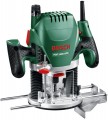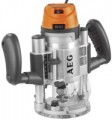Min. speed
The slowest spindle speed (in revolutions per minute) provided by the router motor.
For different jobs, the optimal spindle speed (and, accordingly, the cutter) will also be different. For example, hard materials like stone require fast rotation, but wood does not; some types of nozzles work better at high speeds, others at low speeds, etc. Detailed recommendations for each specific case can be found in special sources. Here we note that the smallest value of the minimum number of revolutions found in modern milling cutters is about 3000 – 5000, and in the most "fast" models this figure can exceed 15000. When choosing, pay attention not so much to the minimum rotation speed as to the total speed range — how it corresponds to the planned tasks.
Max. speed
The highest spindle speed provided by the router motor. Measured in revolutions per minute. For models that do not have speed control (see "Functions"), this paragraph indicates the standard number of revolutions.
For different work, the optimal speed of rotation of the spindle (and, accordingly, the cutter) will also be different. For example, hard materials like stone require fast rotation, but wood does not; some types of nozzles work better at high speeds, others at low speeds, etc. Detailed recommendations for each specific case can be found in special sources. When choosing, it is worth paying attention not so much to the maximum rotation speed as to the general range of speeds - how much it corresponds to the planned tasks. We only note that in models with a large allowable cutter diameter (see below), the maximum rotation speed can be relatively low - the working edge of a large cutter moves quickly even at low speeds, and for effective acceleration of such a nozzle, too much power would be needed.
Max. collet diameter
The largest collet size that the router can use.
A collet is a special type of fastening used, in particular, for installing working nozzles in milling cutters. For proper installation, the size of the collet must match the size of the cutter shank. Modern cutter shanks and collets for them have standard sizes - 6, 8 or 12 mm. The larger the size, the larger the cutter itself, the more powerful the tool and the more difficult the work for which it is intended.
As a rule, the maximum size of the collet is the size of the fixture that is standardly installed in the router. Thinner cutters can be mounted using special adapters (however, care must be taken, as such a nozzle may not be designed for the increased power characteristic of tools with a large collet).
6mm collets are found predominantly in light routers (see "Power"),
8mm mounts are found in most intermediate and professional level tools, and
12mm collets are found in the most powerful and heavy models.
Stroke
The distance by which the height of the cutter can change relative to the support platform of the router, in other words, to what depth the working nozzle can be lowered relative to the upper position. This parameter is used for vertical and edge models (see "Type"); however, edge routers with height adjustment are very rare. In fact, the amount of travel not only describes the maximum working depth provided by the tool, but also indicates the presence of depth adjustment; for models without such adjustment, this parameter is not indicated at all.
As for specific numbers, for simple household work, a stroke of 25–30 mm is considered quite sufficient, and in a more serious tool, values of 70–80 mm can be found.
Functions
—
Soft start. The presence of a soft start engine in the design of the milling cutter. A feature of most modern electric motors is that when connected to the network directly, without control circuits, at the time of start-up, there is a sharp jump in current through the motor. This, on the one hand, creates voltage fluctuations in the mains (which can “knock out” fuses or become fatal for some devices operating nearby), on the other hand, it leads to a sharp jerk of the tool, due to which it can be released from hands (and this cause damage to surrounding objects and even injury). This function also limits the current at the moment of starting the motor. Due to this, the speed increases smoothly, without jerking the tool, and the power grid is not subjected to excessive overloads.
—
Adjustment of frequency of rotation. The presence of a speed controller in the design of the milling cutter. This function allows you to change the spindle speed, adjusting it to different types of work — for example, to effectively cut hard material, you may need a high speed, and with soft woods, you can work at low speeds. Tools with speed control will be useful especially for those who have to deal with a wide variety of materials. In this case, the range of such adjustment may be different.
—
Microlift. The presence in the design of the router of a system for fine-tuning
...the depth with an accuracy of 0.1 mm. The standard setting with the limit pin is very coarse, as the errors are quite large. The microlift is used where it is important to set the depth very accurately. It is implemented mainly by means of a threaded connection that limits the vertical downward movement, or is completely integrated into the vertical travel design, where unlocking is not needed to make the necessary adjustments.
— Backlight. The presence of a lighting system in the design of the router — in fact, an ordinary flashlight that facilitates work in dimly lit places. The need for backlighting may arise even in daylight or bright artificial lighting — the place of work is quite often in the shade (for example, from the head of the operator himself).
— Maintain momentum. The presence in the design of the milling cutter of a system that automatically adjusts the engine operation mode depending on the load on the working nozzle — in such a way that the rotational speed remains constant, does not fall under load and does not increase at idle. Thanks to this adjustment, a constant quality of processing is ensured, practically independent of the pressure on the nozzle, wear of the nozzle and the tool itself is reduced, as well as overall energy consumption.In box
Additional equipment included in the delivery of the router in addition to the device itself.
—
Fresa. Working nozzles — milling cutters — can be included in the delivery set of milling cutters, this eliminates the need to purchase such nozzles separately. On the other hand, before buying a tool with this feature, you should make sure that the complete cutters correspond to the features of the planned work — otherwise you may overpay for unnecessary nozzles. Usually, there are several cutters in the set.
—
Dust collector. A special container for collecting dust, sawdust and other debris generated during the operation of the router. Most often it is made in the form of a soft bag, and a special pipe is used to connect to the tool (a vacuum cleaner can also be connected through the same pipe). Note that the overwhelming majority of modern milling cutters are equipped with nozzles for dust collectors, but the bags in the kit are relatively rare. Usually, a dust bag can be purchased separately, but for some users it is preferable to immediately buy a tool with a bag.
—
Copy base. The copy base is the base (sole) of the router (see "Type"), specially designed to work with copy sleeves. The copy sleeve is a ring fixed on the tool body, into which the cutter is threaded. When working with such a sleeve, the operator rests the outer edge of the ring agai
...nst the template and moves the tool in such a way that the base is constantly pressed against the template. Thus, the distance between the cutter and the template remains unchanged, and the working nozzle repeats the shape of the template; this is indispensable for precise work, especially with lines of complex shape. Many routers allow you to install a copy sleeve on a regular sole, however, there are models in which you need to install a special copy base for this. Such a base has certain differences from the standard one, due to the specifics of the work — in particular, it usually does not have depth adjustment, because. the presence of an adjustment mechanism can adversely affect the accuracy of work.
— Protective limiter. The protective limiter is a small ring that covers the working nozzle. This ring, as the name suggests, provides additional protection for the operator from dust, chips and other debris generated during operation. In addition, it prevents foreign objects (primarily fingers) from getting under the cutter and increases the efficiency of collecting debris in a vacuum cleaner or dust collector (see above). And so that the operator can control the process of work at the same time, the protective limiter is usually made transparent.
— Guide rail. A device designed primarily to ensure that the router during operation can move parallel to the edge of the material being processed. The rail rests against this edge during operation, and the tool itself extends a certain distance from it on special guides. Thus, it is possible to cut recesses parallel to the edge of the workpiece. The distance from the rail to the cutter can be adjusted, some models even provide special scales on the rail itself.
— Case / bag. This category includes all devices designed for storing and transporting tools; at the same time, hard containers in the form of characteristic suitcases are usually called cases, while bags, on the contrary, are made of soft materials. Anyway, the case / bag simplifies storage and carrying: firstly, due to the fact that such devices themselves are more convenient for long-term carrying than a tool; secondly, due to the fact that the router, the power cord, and all additional accessories can be folded into one place, reducing the risk of losing any of it.Noise level
The noise level produced by the router during operation. This parameter is quite approximate, since the actual “loudness” depends not only on the characteristics of the tool itself, but also on the material and shape of the workpiece being processed, the type of cutter, the speed of work, etc. Therefore, in fact, the noise level may differ both up and down; in the characteristics, a certain average value is given, by which, however, it is quite worthwhile to navigate.
The “quieter” the tool, the more comfortable it will be to work with it, the less likely it is that the operator will need protective headphones. At the same time, we note that routers, by definition, are quite noisy — the most “quiet” models give out about 75 dB. Also, keep in mind that the decibel is a non-linear quantity, so it is best to use comparison tables when estimating the noise level.
Here is a simplified version of such a table for the range in which most modern routers operate:
75 dB — scream, loud laughter at a distance of 1 m;
80 dB — motorcycle engine, mechanical alarm at the same distance;
85 dB — a loud cry at the same distance;
90 dB — demolition hammer at a distance of 1 m, a freight car at a distance of 7 – 10 m;
95 dB — subway car (inside or at a distance of about 7 m).

